Default Dashboard View
When you enter a project, you will see the default dashboard view. It can also be accessed through the View dropdown in the top navigation.

The project name (Urgent Care Website Test in this example) is located on the top left of the default dashboard view page. To the right of the project name in parentheses is the number of entries submitted to the project so far (7 Results). When you run a filter, the number of results may change as it will update to match the number of entries that fit your filtering criteria.
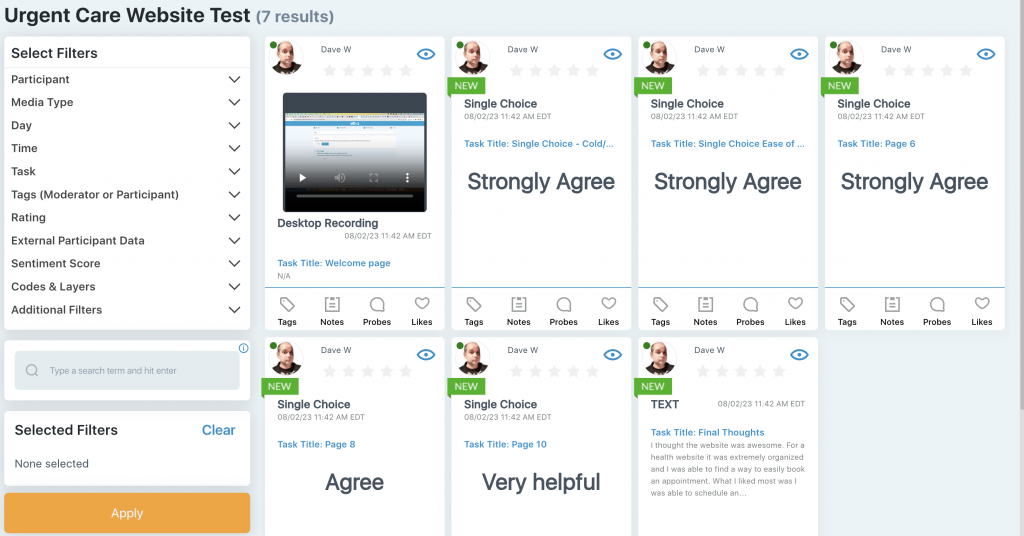
The default dashboard view contains all of the entries submitted to the project sorted from new to old (The newest entry can be found in the top left, while the oldest entry is in the bottom right). In a Desktop Screen Recording only project, if you have survey questions within it, it will also open up cards for them. In the prior screenshot of 7 results, Dave W. has done our desktop screen recording task, which is represented by the top video file, which will show the entire test of his, including the survey questions asked. After that file, you will see six additional questions that were asked.
Individual Entry – Collapsed View
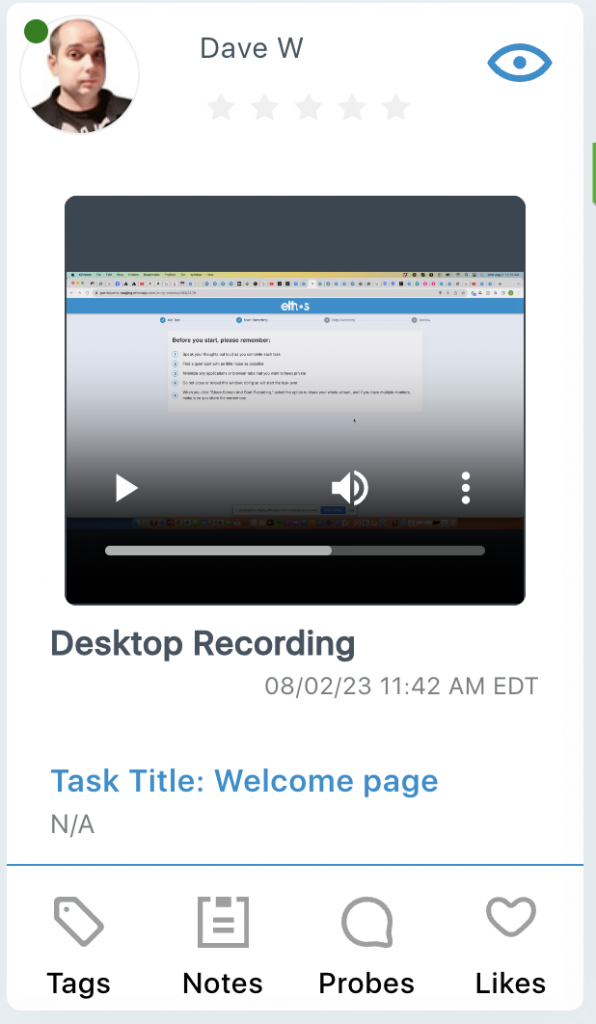
Online Status: The online status indicator is at the top left of each entry card by the participant’s profile picture. The indicator will turn red when the participant is not online, and it will turn green when the participant is online.
Profile Picture: The participant can add a profile picture if they choose.
Participant Name: The participants’ names can be found at the top of the card next to the right of their profile picture in the format first name, last initial.
Viewed Icon: The view or eye icon is located in the top right of the card. When clicked, it will turn the top of the card blue to indicate you have already viewed this entry. This is helpful as it lets you know which entries you have already analyzed.
Star Rating: Moderators have the ability to give each entry a 1-5 star rating. The star rating field is shared amongst moderators. E.g., If one moderator gives an entry 5 stars, other moderators in the project will see it as 5 stars. If another moderator changes it, it will be changed on all moderator accounts.
Entry Media: In a Desktop/Laptop only project, a Desktop Screen Recording, Single Choice, Multiple Choice, Range, or Text will be displayed in the middle of the entry card. Desktop Screen Recording files can be played while in the collapsed view.
Single Choice and Range Task Entries: The participants’ single choice and range responses will be displayed in the middle of the entry card.
Open Text Entries: The open text entries are displayed in the middle of the entry card. Only a portion of the response may be visible if it is a longer entry, but you can expand the entry to view the entirety of the text.
Submission Time: Each task displays the time, date, and time zone the participant submitted the entry.
Task Title: Each task provides a preview of the task title associated with that entry. For a Desktop Screen Recording, the task title will always be the Introduction page name.
Task Description: Each task provides a preview of the task description submitted by the participant. After completing each task, participants are prompted to enter a description that provides more context and details to their entry. Only a portion of the description may be visible in the collapsed view, but you can view the entire description by expanding the entry and navigating to the description tab.
Tags: Tags are not a part of Desktop Only projects but can be utilized in App Only & Desktop + Laptop Projects.
Notes: The notes icon will turn blue when a moderator leaves a note within the entry. You can hover over the notes icon to see how many notes have been left by moderators. If you click the notes icon, you will be brought into the expanded view of the entry where notes are displayed.
Probes: The probes icon will turn blue when probes are present within the entry. In a Laptop/Desktop usability project you will be able to probe the actual video file.
Likes: The likes icon will turn blue when a moderator likes an entry. Multiple moderators can like the same entry, and when you hover over the likes icon, it will show you how many likes that entry has. You can click the heart icon to like an entry.
Individual Entry – Expanded View
You can click anywhere within a closed entry to expand it and see its underlying details. If you want to change your settings for expanded entries, you do so by clicking your avatar in the top right and then clicking the “Project Settings” tab. By changing these settings, you can have all areas of an expanded collapsed by default or only specific areas. In the screenshot below, this user only has no areas collapsed by default.
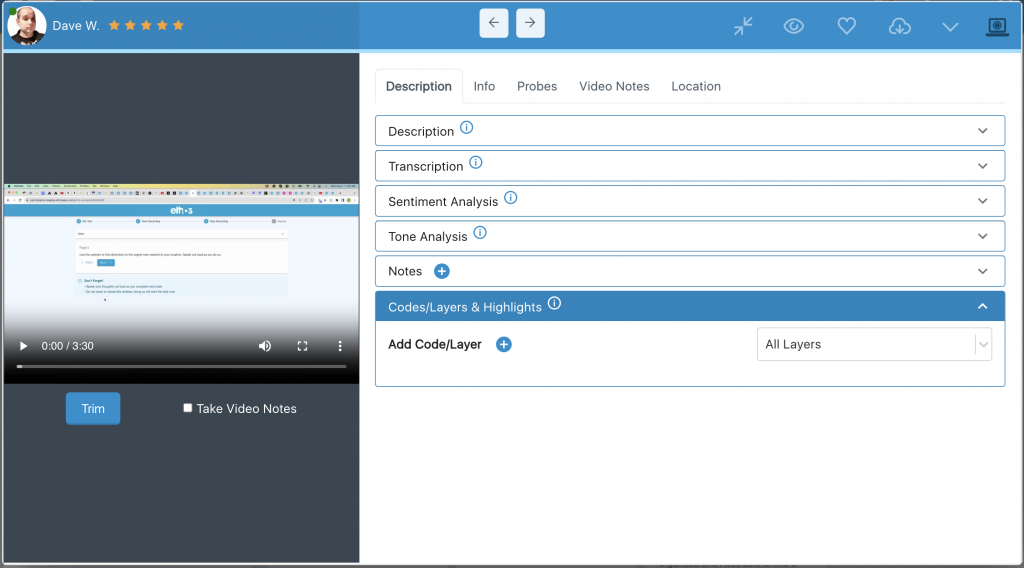
When you expand an entry, the media or response submitted by the participant will be on the left. Media can be expanded further by clicking the icon in the bottom right. Videos can be trimmed by clicking the Trim button. Move the left and right ends of the slider to set the beginning and end of the video clip you want to take. You can then download the trimmed video by clicking the download button.
To the right of the media or response are several different tabs. The Description tab has several different pieces of information about the entry.
Description Tab: In a Desktop/Laptop only project type, this area will be utilized for follow-up text questions to single-choice, range, and multiple-choice questions, along with the open text question type. No description is used in the Desktop Screen Recording video file. The description runs sentiment and tone analysis for open-end text, single-select follow-up text questions, and range follow-up text questions.
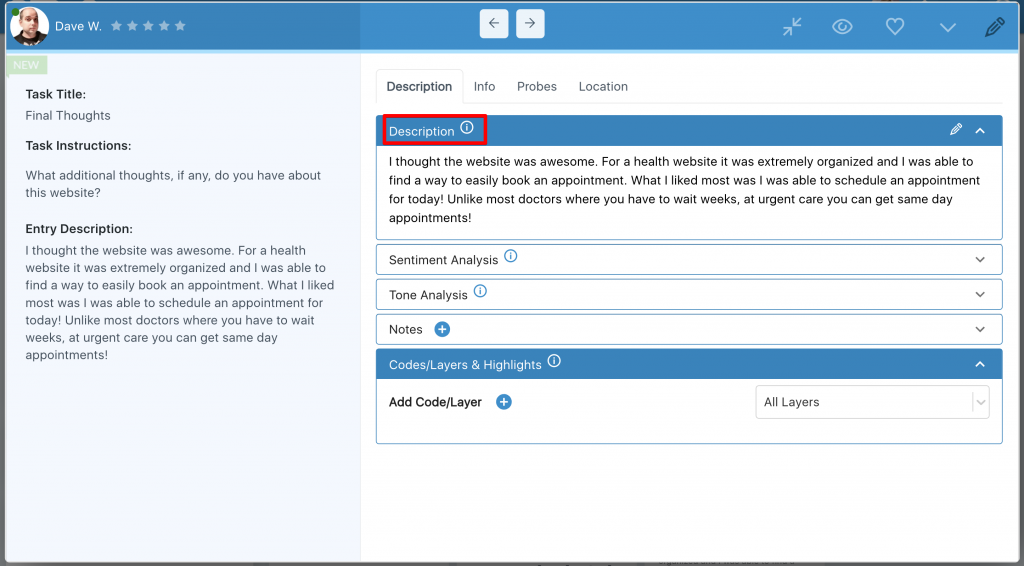
Transcription: Desktop Screen Recording entries will automatically be transcribed. You can edit transcriptions by clicking the pencil icon. Once a transcription is edited and saved, the Sentiment and Tone analysis will run again. You will need to refresh the page on your browser to see the change.
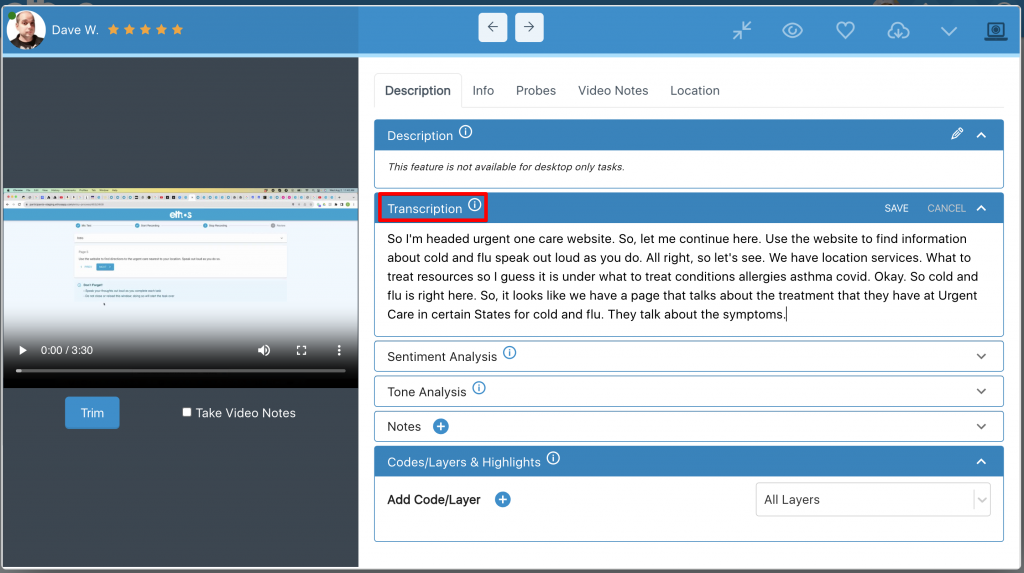
Sentiment Analysis: Sentiment analysis is either run on the transcription of video and audio entries, or on the description left by participants on other entry types. Sentiment scores fall on a range of -1 to 1 with -1 being the most negative, 0 being neutral, and 1 being the most positive. Neutral entries will have a score of 0, negative entries will have a score from 0 to -1, and positive entries will have a score from 0 to 1. You can hover over individual sentences to see the sentiment score for that sentence. If you edit the transcription or description and refresh the page, it will recalculate the sentiment score.
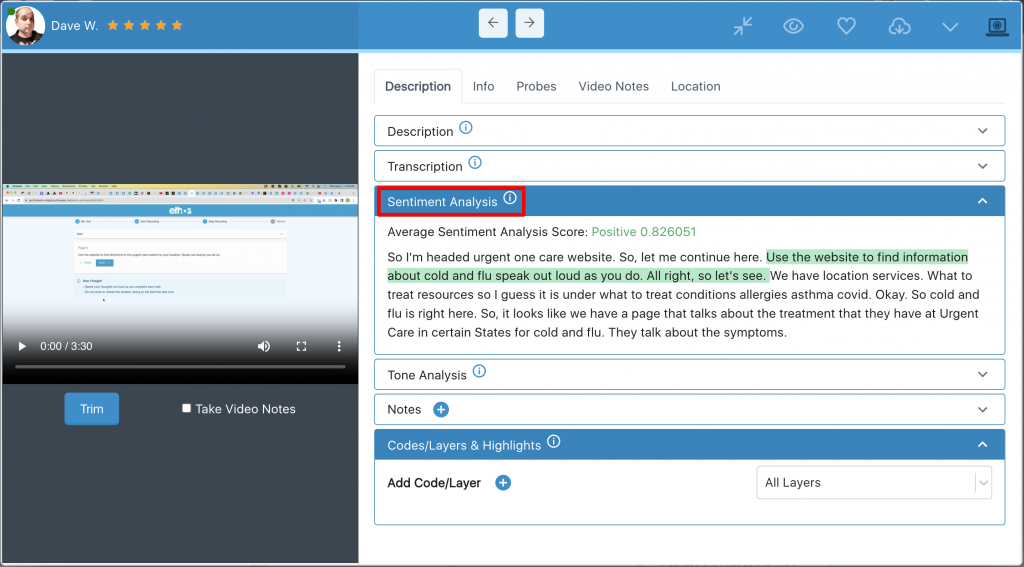
Tone Analysis: The tone analysis engine detects anger, disgust, fear, joy, or sadness conveyed at the entry level. Tone analysis is run on the transcription of desktop screen recordings; on open-end text tasks, it is run on the text; and on single-choice, multiple-choice, and range questions, it is run on the open-end follow-up question (if you include one).
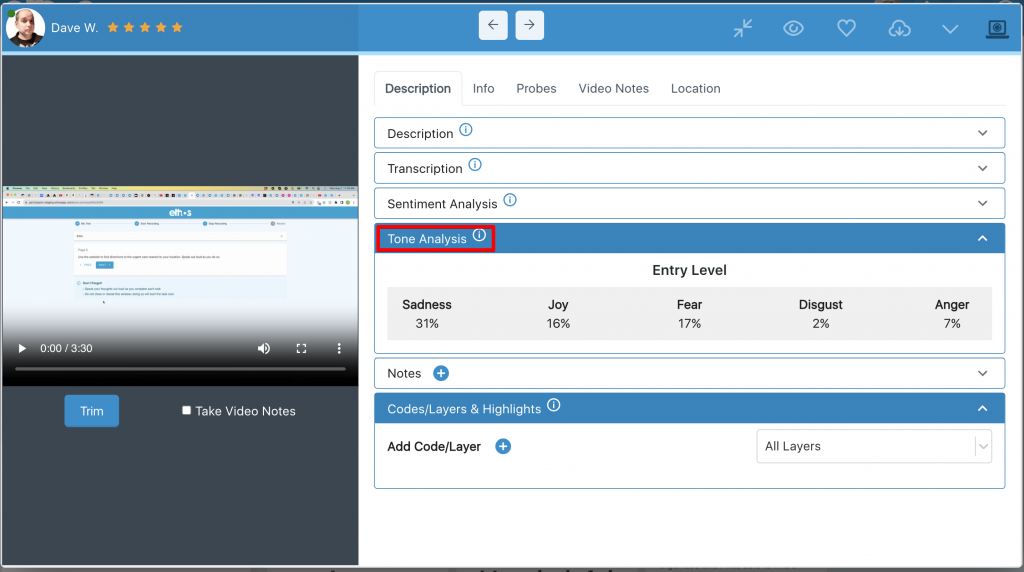
Notes: Moderators can leave notes for themselves and other moderators in the notes area. Notes are viewable by any moderator that opens the dropdown. You can see a list of notes added across all entries in the Moderator Note Feed within the Admin dropdown.
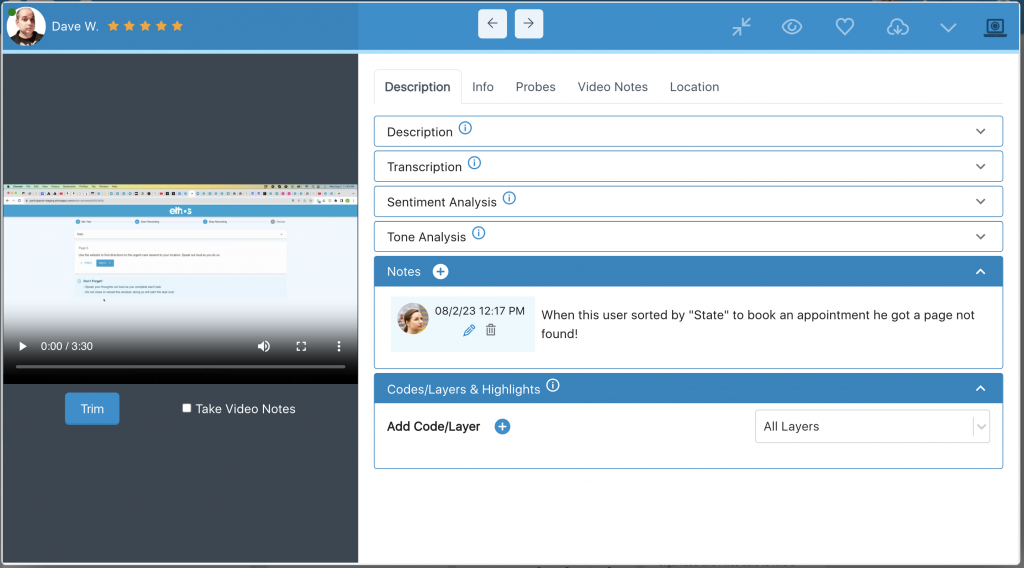
Codes/Layers & Highlights: Codes allow moderators to mark entries for sorting and analysis purposes. Layers are groups of codes. In the platform, you have a few ways of coding. The first way is to click the circular + sign in the Codes/Layers & Highlights section.

When you click, you will get a popup like the one shown below. The example popup has many different layers and codes already made for this project. Our layers are Default, Accessories, Brands, Inside, and Outside. If this is the first time you are coding in your project, you will only have the “Default” layer. If you ever want to add or remove a layer, click the “MANAGE LAYERS” icon.
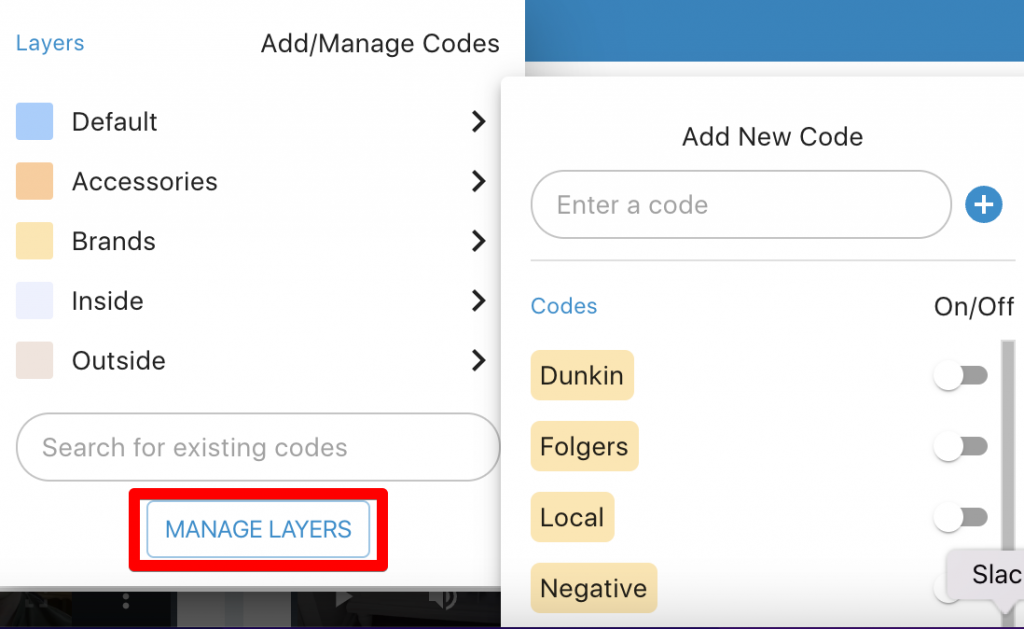
If you want to add a code to a layer, you would click > to the right of the layer you want to add a code to. For this example, we are adding a code to the Default Layer. You would add the code in the Enter a code box in the second popup. In the example below, I typed “Cream & Sugar.” You would hit Enter on your keyboard to submit this as a code or click the blue + icon.
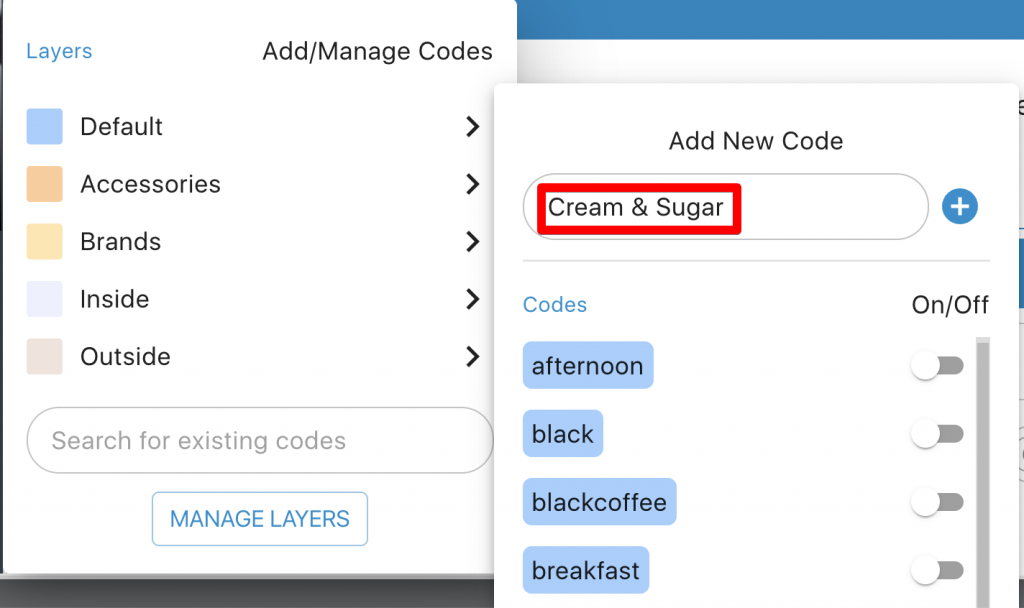
Once submitted, you will see it in the list for that layer. When the radio button is blue (like in the picture below), the code has been applied to this entry. You can toggle codes on and off by clicking the radio button with your mouse.
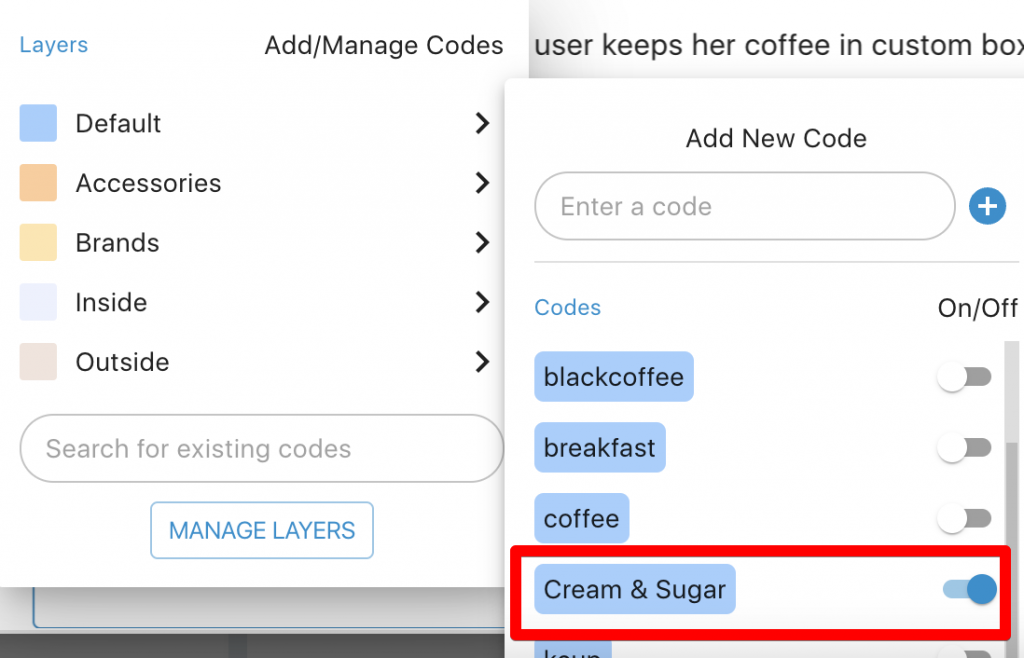
If you exit the popup, you will see all the codes applied so far. All codes used via this method will always have a “0” before the words. So in the case of the code we just created, it says 0 Cream & Sugar. You will see that a second moderator was the one who added the “Cream & Sugar” code in the picture below. If you decide you don’t want this code, you can click the circular X button to the right of the word to remove it.

The other way to code is to highlight text in the Description, Transcription, or Probes tab. In the screenshot below, I highlighted the words, “So, in this first row, this is where I keep all of my teas and coffees.” Once I stopped highlighting, I got the popup where I could now code this set of words or sentences.
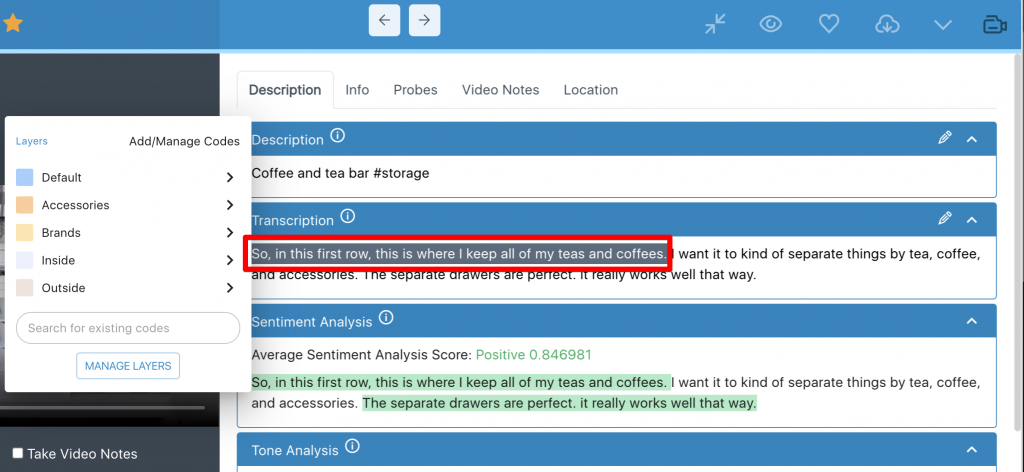
I then coded this sentence as “Kitchen,” shown below.
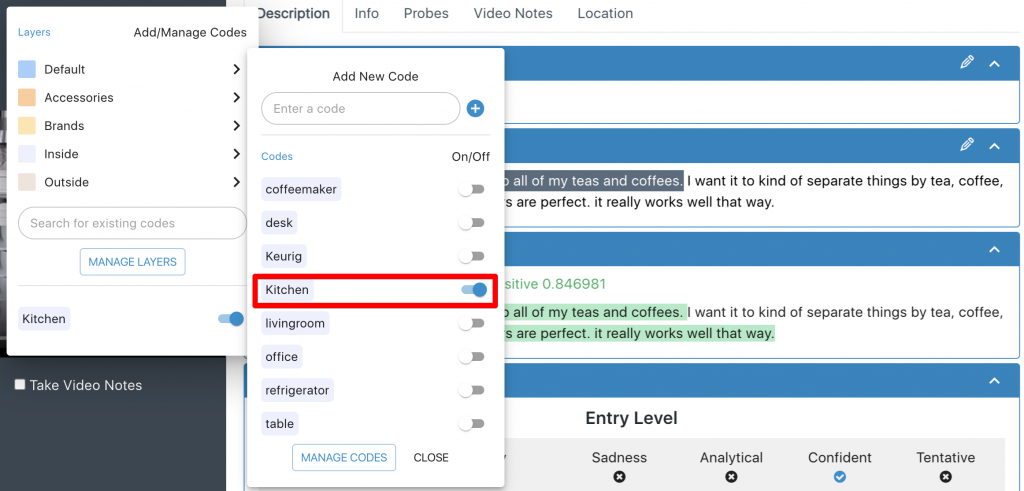
After you click away from the popup to close it, the words or phrases will be highlighted in the color of that layer. In the screenshot below, you will see our phrase is in the gray color that was a part of the “Inside” layer.
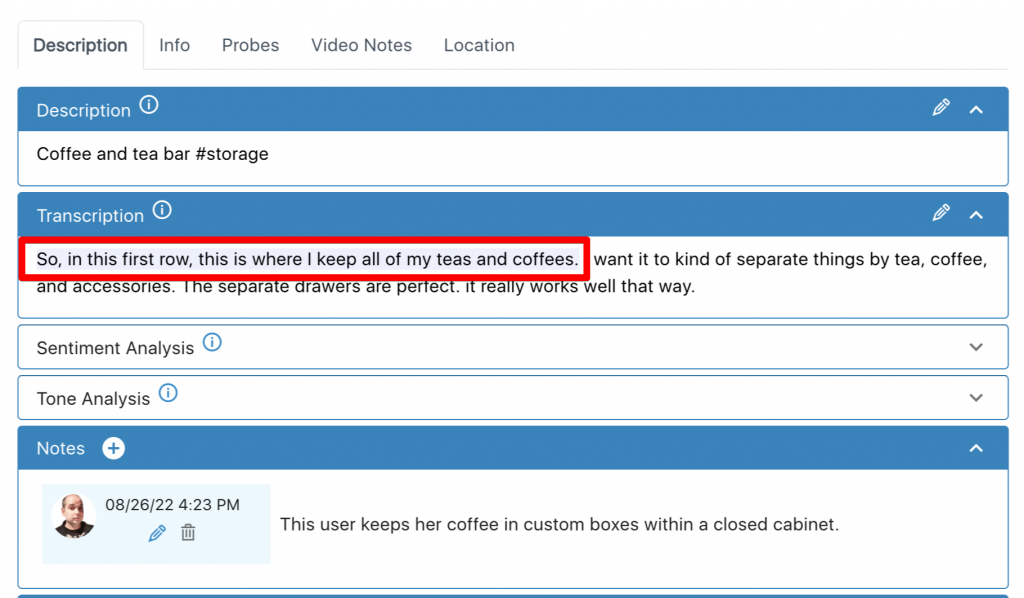
If I click off the popup, I will see “Kitchen” has been added and has a “1” next to it. The 1 indicates that this entry has been highlighted as a code 1x so far.

If you click the word “Kitchen,” you will get a popup:

Upon clicking the icon that the red arrow is pointing to, you will be shown the area highlighted in gray, allowing you to remember the phrase you coded.

If you had highlighted a word in the Probes tab, the above icon (that the red arrow is pointing) would take you to the probes tab where you had previously highlighted text to code.
Info Tab: This tab provides the underlying details of the entry, including the participant’s name, when the entry was submitted (created), the participant’s time zone, the task title, the task instruction, and task media if it’s present. Task media is the media added to a task by the moderator, and you can click on it to view it. This can be a picture or a video.
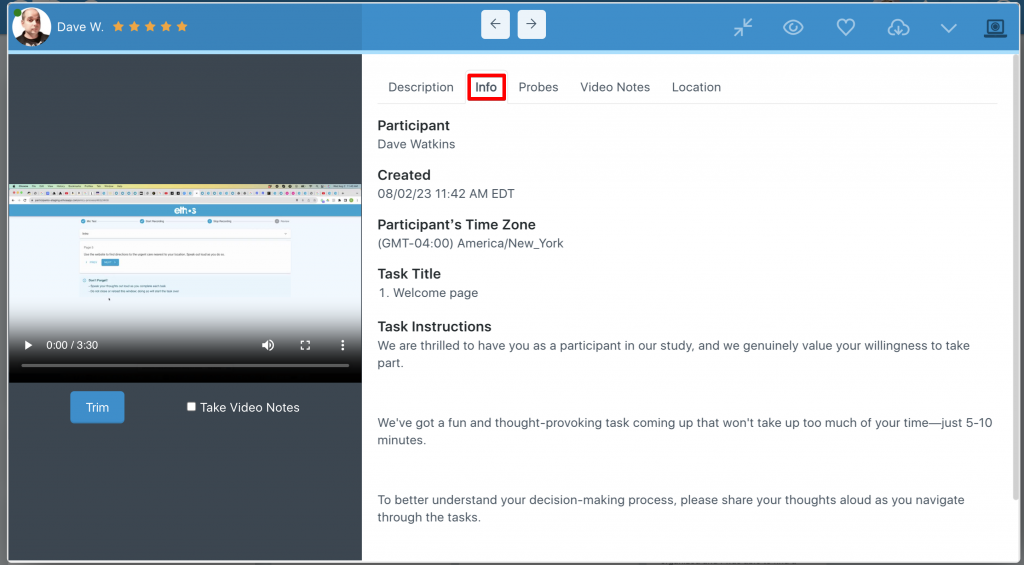
Probes Tab: If you need to ask a follow-up question, you can utilize the probes section within the usability video to pose your question to the participant.
Video Notes: The video notes functionality is available on desktop screen recordings. To view the tutorial on Video Notes, please visit this page: https://helpcenter.ethosapp.com/desktop-video-notes/
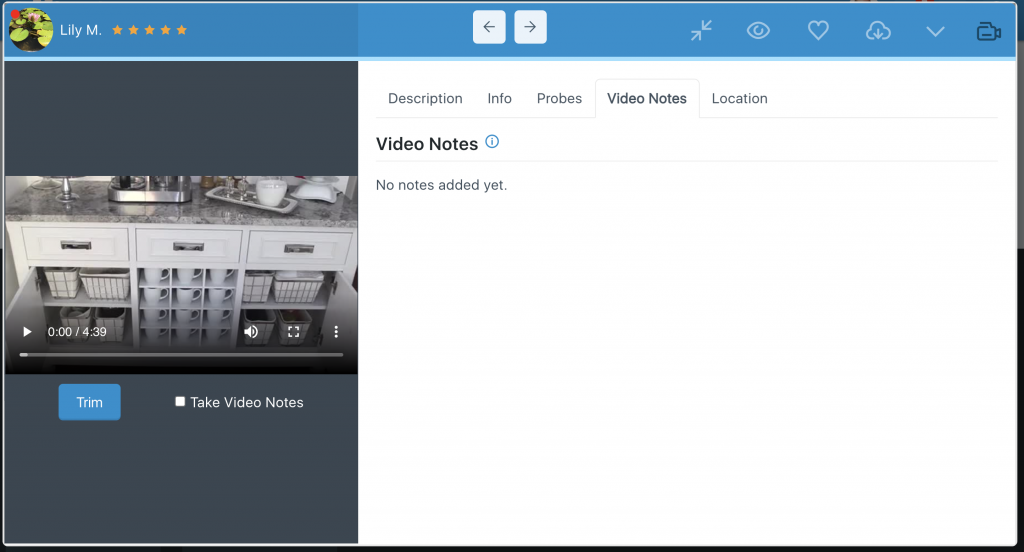
Location Tab: The location tab shows where the participant submitted the entry. Locations only show when ‘capture device GPS location on entries if available’ is selected when creating a new project. It can also be turned on within project settings after the project has been created.
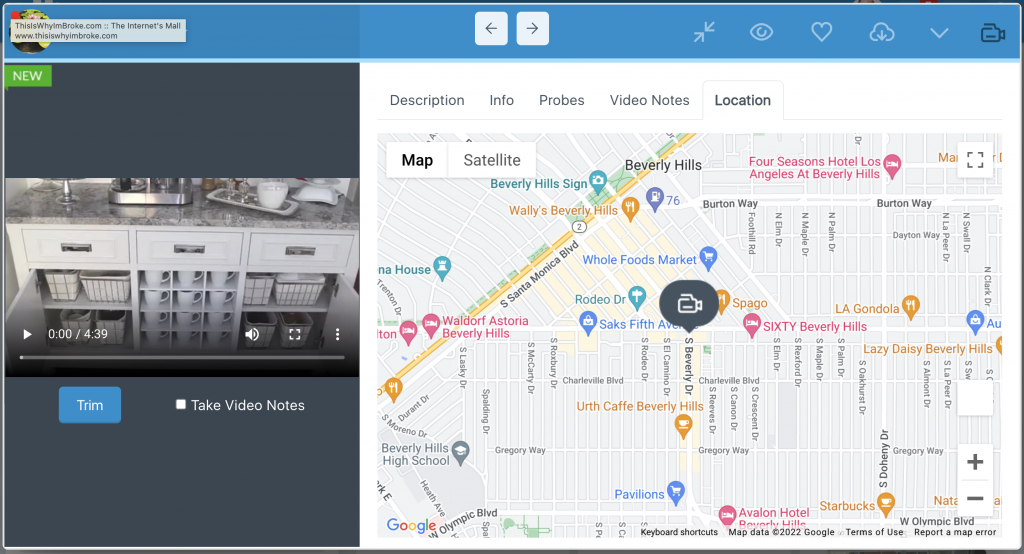
Download: You can download the entry by clicking the download media icon in the top right of an expanded entry.
Delete: You can delete an entry by clicking the dropdown in the top right and clicking the down arrow icon.
Dashboard Filtering
There are several filtering options on the left of the default dashboard view. You can run a filter by selecting the options you want and then clicking apply.
Participant: Allows you to view entries submitted by specific participants.
Media Type: You can filter by only desktop screen recording in a Desktop/Laptop only project. If you want to filter by the survey questions, you can do so by clicking “Task”.
Day: Allows you to filter entries by the day of the week the entry was submitted. Days will only appear if an entry was submitted on that day. Eg, if no participants submit an entry on a Tuesday, Tuesday will not show up as a filtering option.
Time: Allows you to filter entries by time of day. Times will only appear if an entry was submitted during that time frame. Eg, if no participants submit an entry between 10:00 AM – 10:59 AM, 10:00 AM – 10:59 AM will not appear as a filtering option.
Task: Allows you to filter entries by task and sub-questions.
Tags (Moderator or Participant): Tags are not a feature of Desktop/Laptop only projects.
Rating: Allows you to filter by star rating. Star ratings can be adjusted by any manager. Example: If you give an entry a 4-star rating, another manager can change it to 2.
External Participant Data: Allows you to run filters by external participant data if any are present. By default, this will be empty. You can add external participant data through the Admin dropdown in the top navigation. You can also add external participant data through the bulk upload feature on the Participant & User Management page. A tutorial on the page explains this process.
Sentiment Score: You can filter data by overall sentiment score: Positive, Neutral, or Negative.
Codes & Layers: Allows you to run filters by moderator codes that have been added to entries.
Additional Filters:
- Perform and search between codes: This filter is an “and” statement and allows you to search for multiple codes. You would select this option along with at least two codes. For example, if you choose the code “sweet” and then the code “sour” the filter would populate entries that have both of these codes. In comparison, if you were to run a filter that only had a code of “sweet” and a code of “sour” it would populate entries that have either of these codes.
- My Likes: Allows you to see all of the entries you liked yourself.
- With Codes: Allows you to see all entries that currently have codes associated with them.
- Without Codes: Allows you to see all entries that have not been coded yet.
- With Probes: Allows you to see all entries that contain a probe conversation.
- Without Probes: Allows you to see all entries that do not have any probe conversations.
- With Notes: Allows you to see all entries that contain moderator notes.
- Without Notes: Allows you to see all entries that do not contain any moderator notes.
Search Bar: Add a word and click enter to add it as a filter. All words added to the filter through the search bar will filter through task descriptions added by participants, video/audio transcriptions, probes, and open-ended text questions. If you separate words in a search, they will display results in an “or” condition.
Running a Filter: Select all the filtering options you want and click apply at the bottom of the filtering area.